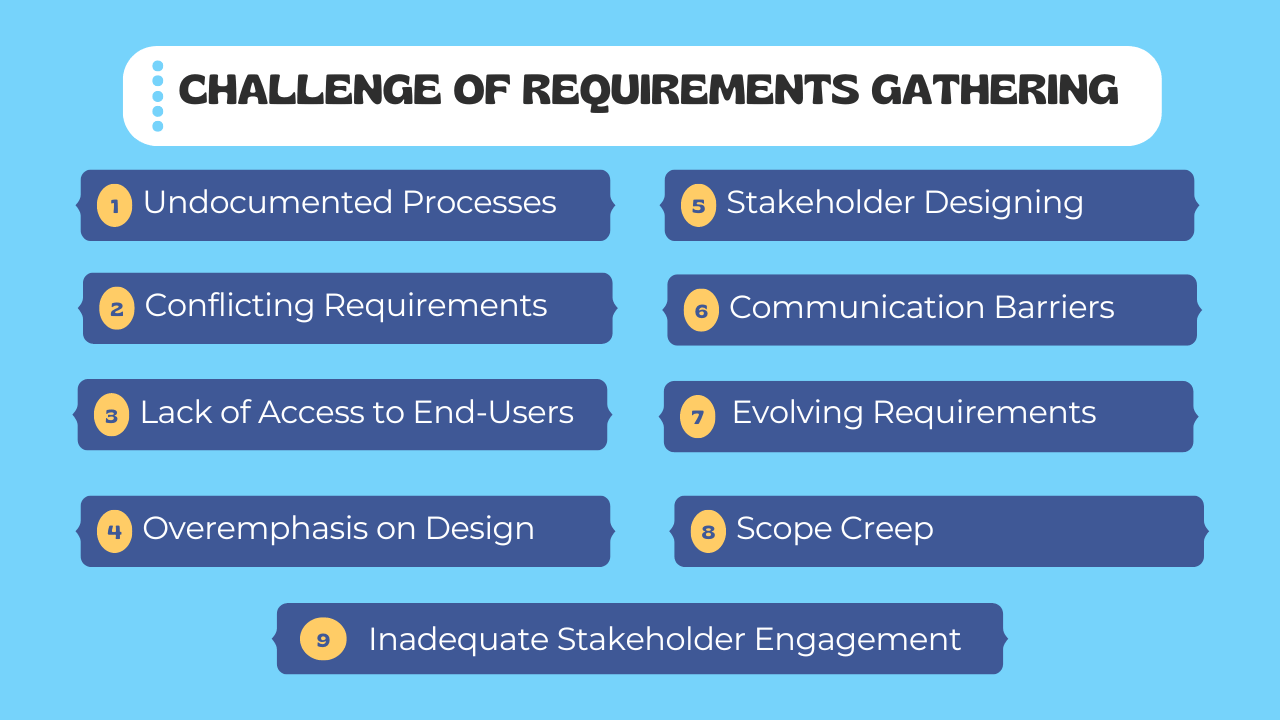
Requirements Gathering Techniques: 15 Proven Methods
 Requirements Gathering Techniques for Effective Project Success
Requirements Gathering Techniques for Effective Project Success
Requirements gathering is the systematic process of identifying, documenting, and managing stakeholder needs to ensure project outcomes align with business objectives. Effective requirements gathering prevents 39% of project failures attributed to poor requirements and reduces costly rework during development.
Key characteristics: Successful requirements gathering involves asking the right questions, actively listening to stakeholders, and uncovering both explicit and implicit needs. It requires understanding the difference between stakeholder wishes and achievable project goals, focusing on requirements rather than predetermined solutions.
Quick Answer: Requirements Gathering at a Glance
| Aspect | Details |
|---|---|
| Definition | Process of identifying, documenting, and managing stakeholder needs |
| Primary Goal | Ensure project outcomes align with business needs and user expectations |
| Key Techniques | Interviews, workshops, surveys, prototyping, observation, document analysis |
| Common Challenges | Conflicting requirements, scope creep, communication barriers, evolving needs |
| Key Deliverables | Requirements documents, use cases, user stories, traceability matrix |
| Best Practice | Use multiple techniques for comprehensive coverage |
| Success Factor | Active stakeholder engagement throughout the process |
Key Insight: No single technique captures all requirements. The most effective approach integrates multiple techniques (interviews, workshops, observation, prototyping) to ensure comprehensive coverage and validation.
This comprehensive guide covers 15 proven requirements gathering techniques, common challenges, best practices, and tools to help you capture complete, accurate requirements for project success.
Table Of Contents-
 What Is Requirements Gathering?
What Is Requirements Gathering?
What Is Requirements Gathering?
Requirements gathering is the process of identifying, documenting, and managing the needs and requirements of stakeholders to meet project objectives.
It is the foundational step in creating a project scope management plan, making it a critical component of project success.
Effective requirements gathering helps in avoiding common pitfalls, such as scope creep and project failures, by ensuring clear and concise project goals from the outset.
Why Is Requirements Gathering Important?
The importance of requirements gathering cannot be overstated.
It ensures that projects are aligned with the strategic goals of an organization, facilitates better communication among stakeholders, and helps in the identification of potential risks early in the project lifecycle.
Moreover, a thorough requirements gathering process significantly reduces the likelihood of project rework, thereby saving time, resources, and efforts.
The Challenge of Requirements Gathering
 The Challenge of Requirements Gathering
The Challenge of Requirements Gathering
Requirements gathering is a complex process that involves understanding and documenting the needs and expectations of stakeholders for a particular solution.
Requirements gathering is not just about collecting a list of what's needed; it's about understanding the business problem, the stakeholders' vision, and translating that into actionable, clear requirements that guide project development.
This phase is crucial for the project's success, as it directly influences the design, development, and implementation stages.
However, analysts often encounter difficulties in this process, including vague project objectives, incomplete information, and changing requirements, which can lead to project delays, increased costs, and dissatisfaction among stakeholders.
Expanding on the challenges faced during requirements gathering in software development, we identify nine common problems that project teams frequently encounter:
-
Undocumented Processes: The lack of properly documented current processes complicates the identification of specific needs and the formulation of new requirements.
-
Conflicting Requirements: Stakeholders often have divergent priorities and expectations, making it difficult to reconcile differences and reach a consensus on the project’s direction.
-
Lack of Access to End-Users: Direct feedback from end-users is invaluable for accurate requirement gathering. Limited access to these users can lead to missed insights into user needs and preferences.
-
Overemphasis on Design: A focus on aesthetic or design elements at the expense of functionality can lead to a product that looks good but fails to meet practical user requirements.
-
Stakeholder Designing: Stakeholders sometimes propose specific solutions rather than expressing needs, leading to a solution-driven approach that may not effectively solve the underlying problems.
-
Communication Barriers: Miscommunication between stakeholders and developers can arise due to differences in terminology, language barriers, or simply poor communication practices.
-
Evolving Requirements: As the market and technology landscape changes, so do the project requirements. Keeping up with these changes and managing their impact on the project can be challenging.
-
Scope Creep: Without a clear definition and control of project scope, new requirements can continue to be added without proper evaluation, leading to project delays and budget overruns.
-
Inadequate Stakeholder Engagement: Engaging stakeholders who have a vested interest in the outcome of the project is crucial. Failure to involve all relevant parties can result in missing critical requirements or gaining buy-in too late in the process.
Techniques for Effective Requirements Gathering
Several techniques can be employed for effective requirements gathering, each with its own set of advantages.
Choosing the right mix of techniques is key to covering all project areas and obtaining the most reliable data.
Interviews
Technique Overview: Interviews involve one-on-one conversations with stakeholders or group interviews to gather detailed information about the project requirements. Preparation is crucial for maximizing the effectiveness of interviews, allowing for the collection of comprehensive and relevant information.
Use Case Example: When developing a new customer relationship management (CRM) software, the project manager conducts interviews with sales representatives to understand their needs, challenges with the current system, and desired features in the new CRM.
Focus Groups
Technique Overview: Focus groups gather a small, diverse group of stakeholders to discuss their needs and expectations, facilitated by a moderator. Focus groups assemble prequalified stakeholders and subject matter experts to discuss their expectations and attitudes towards a proposed project, facilitating a deeper understanding of stakeholder needs.
Use Case Example: Before launching a new mobile app, a focus group session is held with potential users to gather feedback on app concepts, usability expectations, and essential features.
Facilitated Workshops
Technique Overview: Facilitated workshops are structured sessions that bring together cross-functional stakeholders to define and prioritize project requirements collaboratively. These sessions foster creativity, trust, and communication among participants, making them a valuable technique for gathering comprehensive requirements.
Use Case Example: A software development company organizes a workshop involving developers, UI/UX designers, and end-users to collaboratively define the user interface and workflow of a new application.
Surveys and Questionnaires
Technique Overview: This technique involves distributing surveys or questionnaires to a large audience to collect quantitative and qualitative data about their requirements and preferences. This technique allows for the gathering of quantitative and qualitative data, which can be easily analyzed for insights.
Use Case Example: An e-commerce company distributes an online survey to its customers to identify features and improvements they would like to see in the next website update.
Brainstorming
Technique Overview: Brainstorming sessions encourage the generation of a wide range of ideas in a short period, usually involving a group of stakeholders. This technique is ideal for initiating the requirements gathering process.
Use Case Example: A team meeting is held to brainstorm potential features for a new project management tool, encouraging free flow of ideas without immediate critique.
Mind Mapping
Technique Overview: Mind mapping is a visual technique used to organize and categorize ideas or requirements, facilitating understanding and analysis.
Use Case Example: After a brainstorming session on a new health app, the project manager uses a mind map to categorize ideas into features, user interface elements, and backend requirements.
Role-play
Technique Overview: Role-play involves stakeholders assuming roles and acting out scenarios to explore and identify requirements from different perspectives.
Use Case Example: To improve a hotel booking website, team members role-play as different types of users (e.g., business travelers, families) to identify diverse user requirements and pain points.
Observations
Technique Overview: Observations involve watching end-users interact with a system or performing their tasks to identify unarticulated needs.
Use Case Example: Observing retail employees use an inventory management system to spot inefficiencies and user interface issues that users might not have explicitly reported.
Document Analysis
Technique Overview: This technique entails reviewing existing documentation to identify requirements, standards, or constraints that need to be considered. Analyzing existing documentation can reveal insights into the project requirements, leveraging previous work and existing knowledge bases to inform the current project.
Use Case Example: Analyzing compliance documents and previous project reports to ensure that the new banking software meets all regulatory requirements and addresses past challenges.
Prototyping
Technique Overview: Prototyping creates a preliminary version of a product to explore concepts, design choices, and gather early feedback from users.
Use Case Example: Developing a clickable prototype of a mobile app to test the user experience and gather feedback on navigation, layout, and core functionalities.
Benchmarking
Technique Overview: Benchmarking involves comparing the project's practices or metrics against those of leading competitors or industry standards.
Use Case Example: Comparing the performance and features of the company's software against the market leaders to identify areas for improvement and innovation.
Use Cases and Scenarios
Technique Overview: Use cases and scenarios describe the interactions between a user and a system to achieve a goal, providing a clear description of system behavior.
Use Case Example: Writing use cases for an online booking system that detail the steps a user takes to search for, select, and book a hotel room, identifying specific system requirements and user expectations.
Interface Analysis
Technique Overview: Interface analysis focuses on the interactions between the system and other systems or user interfaces, identifying requirements for integration and interaction.
Use Case Example: Analyzing the interface between a new sales software and existing CRM tools to ensure seamless data exchange and user interaction.
Existing Data Migration/Conversion
Technique Overview: This involves planning for the migration of existing data into a new system, ensuring data integrity and compatibility.
Use Case Example: Developing a detailed plan for migrating customer data from an old database to a new CRM system, including data cleansing, mapping, and validation processes.
Release Plan (Phased vs. Big Bang)
Technique Overview: Deciding whether to release the project's deliverables all at once (big bang) or in phases over time based on strategic, technical, and operational considerations.
Use Case Example: A software company is upgrading its flagship product. Instead of launching a completely overhauled version at once (big bang), the project team opts for a phased release. Initially, they release the updated user interface to gather user feedback. Subsequent phases will introduce new functionalities, integrating feedback from the earlier phase to minimize risk and ensure a smooth transition for users.
Integrating Techniques for Comprehensive Requirements Gathering
Often, the most effective approach involves integrating multiple requirements gathering techniques.
For example, initial interviews with key stakeholders can help define broad project goals, which can then be refined through workshops and brainstorming sessions.
Prototyping can be used to visualize and validate these requirements, with surveys and questionnaires gathering broader feedback on the prototype.
Observations and document analysis can ensure that all operational and compliance requirements are met, while interface analysis and existing data migration plans are crucial for projects involving integration with existing systems.
Incorporating feedback at each stage and employing a variety of techniques ensures a holistic understanding of project requirements.
This multifaceted approach allows project teams to capture a wide range of needs and expectations, leading to more successful project outcomes.
Ensuring Thoroughness of Requirements Gathering
The Iterative Process
Adopting an iterative and agile process can help in capturing all scenarios.
This involves regularly reviewing and verifying the requirements to ensure they are complete and reflect the project's needs accurately.
Iterative processes allow for adjustments to be made as the project evolves, ensuring that the final product meets the stakeholders' expectations.
Requirement Management Tools
Using a requirements management tool can streamline the process of organizing, tracking, and prioritizing requirements.
Tools like JIRA (opens in a new tab) or Confluence (opens in a new tab) can be particularly useful in managing requirements effectively, offering features such as live status updates on tasks and the ability to associate development tasks directly with requirements.
Conclusion
Requirements gathering is the foundation of successful project execution. By systematically identifying, documenting, and validating stakeholder needs, teams prevent costly rework and deliver solutions that truly meet business objectives.
Key Takeaways:
- Use multiple techniques: No single method captures all requirements. Combine interviews, workshops, observation, and prototyping for comprehensive coverage
- Engage stakeholders continuously: Active engagement throughout the process prevents misalignment and ensures buy-in
- Address challenges proactively: Anticipate conflicting requirements, scope creep, and communication barriers with structured resolution processes
- Document and validate: Create clear documentation and validate requirements iteratively with stakeholders
- Leverage appropriate tools: Use requirements management tools to organize, track, and maintain traceability
Effective requirements gathering directly impacts project success. Invest adequate time in this critical phase to establish a solid foundation for design, development, and testing. For deeper coverage of the complete requirements analysis process, see our guide on Requirement Analysis in SDLC.
Quiz
Test your understanding of requirements gathering techniques with this comprehensive quiz.
Quiz on Requirements Gathering Techniques
Your Score: 0/15
Question: What is the primary purpose of requirements gathering?
Frequently Asked Questions
Frequently Asked Questions (FAQs) / People Also Ask (PAA)
How do you initiate the requirements gathering process?
What if stakeholders are uncertain about their requirements?
How often should requirements be revisited and refined?
How can I verify that all requirements are comprehensively captured?
Can requirements evolve during the project?
How critical is stakeholder engagement in requirements gathering?
What tools are recommended for requirements management?
How do you handle conflicting requirements from different stakeholders?
What is the difference between functional and non-functional requirements?
How do you prioritize requirements effectively?
What are the signs of poor requirements gathering?
How do remote teams conduct effective requirements gathering?
What role does documentation play in requirements gathering?
How do you validate that requirements are testable?
What best practices ensure effective requirements gathering overall?
Continue Reading
Learn about Software Development Life Cycle (SDLC)Get an overview of the Software Development Life Cycle (SDLC), and learn about the key phases and activities involved.
Planning Phase in SDLCLearn about project planning, feasibility studies, scope definition, and creating effective project charters.
Design Phase in SDLCLearn about the design phase of the Software Development Life Cycle (SDLC), and the key activities and deliverables involved.
Development Phase in SDLCExplore the activities and collaboration of different roles during the development phase of the SDLC, and understand how unit testing and automation contribute to a quality software product.
Testing Phase in SDLCExplore the SDLC testing phase and its critical role in ensuring software quality and reliability. Learn about different testing types, methodologies, and their importance.
Deployment Phase in SDLCDiscover the SDLC deployment phase, its importance, and how to ensure a successful software launch. Learn about different deployment strategies and best practices.
Maintenance Phase in SDLCExplore the crucial maintenance phase of the Software Development Lifecycle (SDLC), its importance, and best practices to keep your software in top shape.
Waterfall model in SDLCDiscover the ins and outs of the Waterfall model, a fundamental Software Development Life Cycle (SDLC) methodology. Learn its advantages and disadvantages.
Effective Requirements Gathering: Techniques and TipsDiscover effective strategies for business analysts to master requirements gathering, ensuring projects are built on clear, actionable requirements.